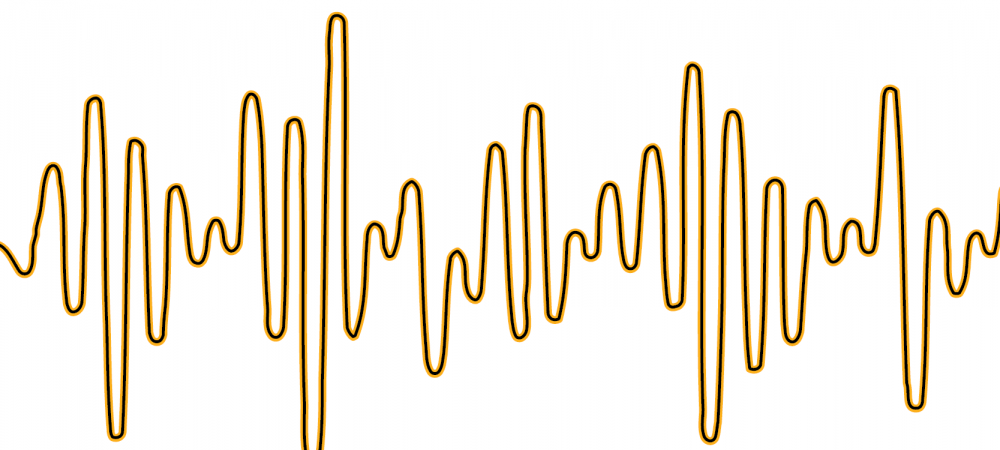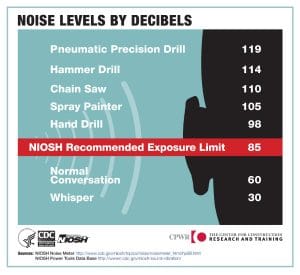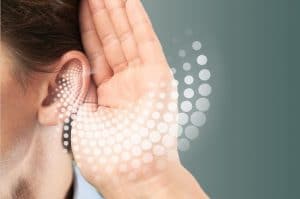
Hearing loss is typically painless, and NIHL (noise-induced hearing loss) is one of the most common, preventable work-related illnesses worldwide. Occupational hearing loss is a permanent, non-treatable condition. This can cause several issues for employers and employees, especially when a person’s ability to communicate on the job becomes impaired.
Benefits of Hearing Protection
Hearing protection aims to safeguard an individual’s auditory health by reducing exposure to excessive levels of noise. By using earplugs, earmuffs, or other protective devices, hearing protection aims to attenuate the intensity of noise entering the ears, preventing or minimizing the risk of auditory impairment. Its goal is to maintain healthy hearing levels and prevent long-term damage caused by loud or prolonged exposure to noise in various occupational environments.
Hearing protection can aid in the prevention of:
● Noise-induced hearing loss (NIHL): Temporary or permanent damage to the auditory system caused by exposure to excessive noise levels. This damage can cause a reduction in hearing ability and affect one’s capacity to perceive sounds
clearly or at certain frequencies. The degree of hearing loss may vary from mild to severe and can impact one or both ears.
● Tinnitus: A condition characterised by the perception of sound in the ears or head without any external source of that sound. The sound is described as a “ringing” noise and can vary in pitch, volume and duration. Tinnitus can affect one or both ears.
● Hyperacusis: A condition characterised by an increased sensitivity to certain everyday sounds or noises. Individuals with this condition perceive sounds that others consider normal as intolerably loud, uncomfortable, or even painful.
● Auditory Fatigue: Also known as temporary threshold shift (TTS), this condition refers to a temporary reduction in hearing sensitivity following exposure to loud noises or prolonged exposure to noise over time. It may manifest as a feeling of muffled hearing, difficulty understanding speech, or a sensation of fullness in the ears.
Types of Hearing Protection
There are three major types of hearing protection devices: Earplugs, Earmuffs (including cap-mounted), and Semi-insert earplugs
● Earplugs are directly inserted into the ear canal to create a seal that limits how much sound reaches the ear drum. The positioning of earplugs makes them a preferred option for hot or humid environments and allows for other safety equipment to be worn without impacting the effectiveness of the hearing protection device. There may be an initial discomfort when utilizing earplugs, but it typically diminishes over time as the individual grows accustomed to them. This type of hearing protection has several different styles including roll-down foam, push-to-fit foam, formable, pre-molded, or custom-molded.
● Earmuffs are an option for those who prefer a hearing protection device that seals around the ears as opposed to one that is inserted into the ear canal. These are rigid ear cups made of foam, fluid or gel cushions held in place by metal or plastic spring-loaded headbands. Available in multiple shapes and sizes to accommodate different ears, cheekbones, and heads, earmuffs can be a great alternative to earplugs. However, the seal may be compromised with the use of other protective equipment. Safety equipment like helmets, face shields or respirator face pieces may dislodge the earmuffs, and eyewear arms or bands and communication devices may compromise the seal. In warmer environments, the ear cups may also cause sweating in or around the ear. Sweat covers are available to help manage this. Cap-mounted earmuffs are also available for those who need to wear a hard hat as well as hearing protection.
● Semi-insert or semi-aural earplugs, also known as banded, canal caps or concha-seated earplugs are made up of soft tips held in place by a spring-loaded band. This band can be worn over or behind the head or under the chin if preferred. These earplugs seal the ear canal at the entrance as opposed to being inserted into the canal in order to protect from sound. This style of earplug is good for situations where frequent removal or repositioning is needed though the band may be dislodged easily if other safety equipment is required.
What is noise?
Noise is unwanted sound measured on a decibel scale. Noise levels for some familiar sounds are shown below. It is important to note that noise exposure does not just occur at work. Any loud activities that you participate in during your free time add to your safe noise exposure levels for the day.

What if you are overexposed to noise?
Excessive noise damages sensitive structures in the inner ear that cannot be repaired, resulting in irreversible hearing loss. This type of hearing loss distorts sound, making it less clear.
People who have hearing loss miss out on conversations and interactions with others. They are less likely to engage in social activities and can put themselves and others at risk on the job site when hearing loss impedes their ability to hear warning signals and other important cues. Hearing loss is also associated with other harmful conditions including dementia. – WorkSafe BC

What are Safe Noise Levels?
The legal limit for workers is an 8-hour average noise exposure of 85 dB, or a 10-hour average noise exposure of 84 dB. This limit is enforced by Occupational Health & Safety (OH&S).
Noise exposure occurs exponentially and with every 3 dB increase, safe exposure duration is reduced by half. If you work with impact noise, exposure levels will be around 25 seconds at 114 dB, which is why hearing protection is critical.
How to properly insert hearing protection devices
Proper fit of hearing protection devices is crucial to ensuring the protection of the wearer. When worn correctly, hearing protection can reduce noise exposure and the risk of noise-induced hearing loss. If the hearing protection devices are not worn properly, the effectiveness of the hearing protectors is greatly reduced, putting the wearer at risk of noise exposure.
Initial Signs of Hearing Loss

You have difficulty hearing people when they speak.

You’re frequently asking people to repeat themselves.

You have a hard time hearing women’s and children’s voices.

You favour one ear over the other.

You have a ringing sensation in one or both ears.

People tell you that you seem to have difficulty hearing
Custom-Molded Ear Plugs
Despite the dangers of hearing loss, 24% of noise-exposed workers report that they often fail to wear noise protection PPE regularly. There are various styles of hearing protection and the right selection depends on a variety of factors, from the nature of the job to your individual comfort.
SureHire offers custom-molded earplugs made of medical-grade silicone that is soft and durable enough to last 5 years or more with proper care. They also come with a protective case to prevent accidental loss. With a variety of styles to choose from, they can be customized to ensure appropriate attenuation. There are many benefits to using custom-molded hearing protection.
Additional Prevention Tips
Loud machines and equipment are among the most common causes of harm to workers’ hearing. As a guideline, if you are within 1 metre of another person at work and have to shout to be heard, the noise level is likely excessive (WorkSafe BC). Several types of chemicals, including certain pesticides, solvents, and pharmaceuticals containing toxic substances, can impact hearing as well.
Both long-term exposure to noise and short-term exposure to higher levels of noise can adversely affect hearing, whether at work or at home. Risk prevention should take a multi-prong approach that includes training and education, engineering controls, administrative controls and use of PPE.
